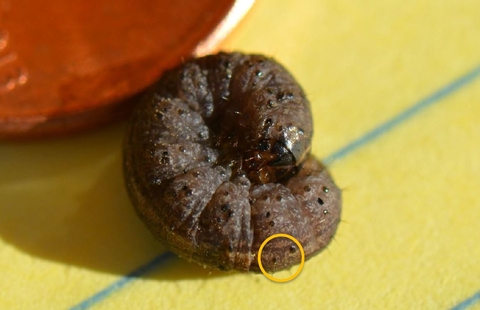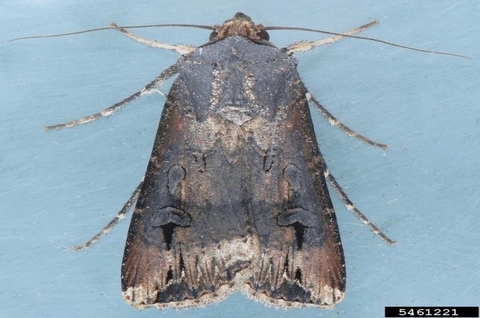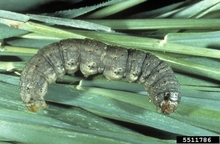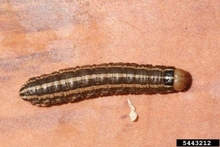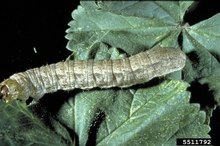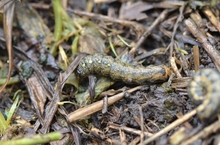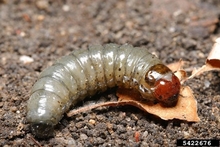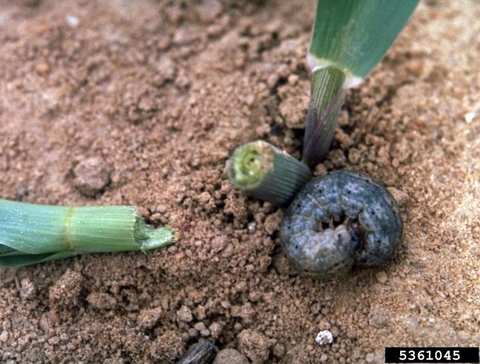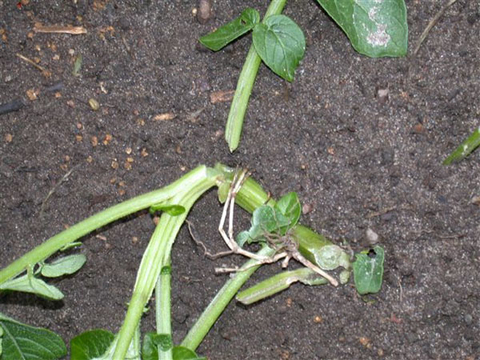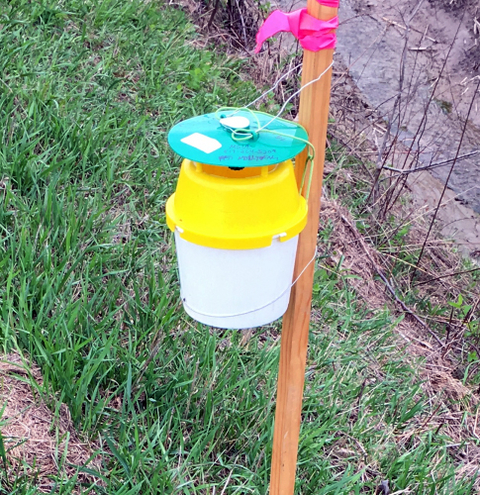Quick facts
- Cutworm is a generic name for the caterpillar stage of multiple species of moths.
- Cutworms get their name because they cut down young plants as they feed on stems.
- Seedlings are most susceptible to cutworm feeding.
- Physical removal is effective in many cases.
Cutworms can cause serious damage to crops. Specific pest management information for black cutworms on corn and soy is available in the Crop Production section of this website.
How to identify cutworms
Most cutworm species look very similar.
- Caterpillars are smooth with very few hairs and are about two inches when fully grown.
- They typically curl into a tight 'C' shape when disturbed.
- They can range in color from brown or tan to pink, green or gray, and black. Some cutworms are a uniform color while others are spotted or striped.
- Some larvae are dull and others appear glossy.
Common cutworm species in Minnesota
The most common species of cutworm occurring in Minnesota are the bronzed cutworm, variegated cutworm, black cutworm, dingy cutworm, glassy cutworm and army cutworm.
Adults are generic, grey-brown moths.
- Cutworms adults generally have a body length of about one inch with wingspans up to 1 1/2 inches across.
- Moths are brown or black insects showing various splotches, or stripes in shades of gray, brown, black or white.
- Typically, the front wings are darker than the hind wings and are patterned.
Biology of cutworms
Some cutworm species, including black and variegated cutworms, migrate into Minnesota from the south each year. However, dingy, bronzed, and glassy cutworms are native to Minnesota and overwinter as eggs or larvae in weedy or grassy areas.
Moths mate and lay eggs from early spring (black cutworm) to late summer or fall (dingy, glassy and bronzed cutworm).
- Female moths can lay hundreds of eggs, one at a time or in small clusters.
- Many cutworms are active early in the spring when few plants are growing, and moths will lay eggs on any green plants, including weeds and cover crops.
- Eggs are deposited on or near low-growing plants and plant residue.
- Young larvae feed on leaves or small roots until they reach about 1/2 inch long when they move on to seedling stems by cutting or burrowing through them.
- The number of cutworms present is controlled by weather, especially rainfall.
- They may go through three generations per year.
Damage
Cutworms curl their bodies around the stem and feed on it. This feeding causes the plant to be cut off just above the soil surface. The number of cutworms found can vary a lot each year. When their numbers are high, there can be severe damage.
- Black, bronzed and army cutworms can cause serious injuries, attacking and cutting new plants nightly.
- The variegated cutworm can climb the stem of trees, shrubs, vines and garden plants and eat the leaves, buds and fruit.
- Species such as glassy cutworms remain in the soil and feed upon roots and underground parts of the plant.
- Cutworms feed in the evening or night and hide in plant debris or soil during the day and it is not uncommon to see damaged or clipped plants and no larvae.
- New transplants or young plants have more chances of injury because their stems are smaller and more tender.
- Damage is most severe in the early season when plants are small and have tender tissue.
- Cutworms are active throughout the summer but are rarely a problem after spring.
- Adult moths do not damage plants.
Cutworms are general feeders that can attack a wide range of plants.
- Vegetables they feed on include asparagus, beans, cabbage and other crucifers, carrots, celery, corn, lettuce, peas, peppers, potatoes and tomatoes.
- A few species feed on turfgrass.
Managing cutworms in gardens
Check your plants in the morning when damage is fresh and easier to see.
- Watch for plants cut off near the ground or plants that are wilting (when cutworms chew on the stems but do not sever the plant).
- If you see droppings on the ground, it is a sign of cutworm feeding.
Check your garden for cutworms in the late afternoon and evening when cutworms are more active.
- To confirm that cutworms are present, run your hand over the soil, rolling over soil clumps and other potential hiding places, within one foot of the damage.
- If cutworms are present, they will curl up into a “C”, when disturbed.
- For some species that hide in the soil, like black cutworm, a noticeable hole may be present in the soil near damaged or cut plants.
Control of cutworms is more effective when the larvae are small. For some crops, such as tomatoes, peppers and celery, you may run into cutworms that climb stems and feed on leaves and fruit later in the growing season.
Change the garden environment.
- Remove plant residue to help reduce egg-laying sites.
- Remove weeds, which serve as an alternate host for young cutworm larvae.
- Till your garden before planting which helps expose and kill larvae that have lived through the winter.
- Use compost instead of green manure as manure may encourage egg-laying.
- Till your garden in the fall to destroy larvae or pupae in the soil.
- Maintain a three to four-foot buffer of dry soil along the edge of the garden to make it unattractive to cutworms.
If larvae are discovered during monitoring, physically remove and crush or drop the insects into soapy water.
Use a barrier to keep cutworms out.
- Place aluminum foil or cardboard collars around transplants. This creates a barrier that stops cutworm larvae from feeding on plants.
- Place the collars around plants such that one end is pushed a few inches into the soil, and the other end extends several inches above ground. This should prevent most species of cutworms from getting to your plants.
Using insecticides
Pesticides are usually not necessary in the home garden.
Managing cutworms on vegetable farms
You can monitor for different species of cutworms in different ways.
Monitoring for adults
Some species of cutworms live in Minnesota year-round, while others come here on weather fronts. Black cutworm is a species that comes to Minnesota each spring on weather fronts. It is a species commonly found damaging vegetable plants, and you can use pheromone traps and degree days to time scouting and management actions. The goal of the traps isn’t to reduce populations but to gauge population size.
- Black cutworm adults can be trapped using a bucket trap and black cutworm lure.
- Check traps weekly or after large weather fronts move in from the south.
- You can then use degree days to estimate when the best time is to scout for black cutworm caterpillars.
- Black cutworms use a degree day base of 50.
- When you catch 8 or more moths over a two-night period, set that as 0 in your degree day (dd) calculation.
- Eggs hatch at 90 dd, the caterpillars enter the stage where they do significant damage at 431 dd, pupation occurs and damage stops at 641 dd.
Monitoring for caterpillars
- Caterpillars are only able to cut after feeding on roots or leaves first.
- Scouting fields at dusk or early evening will help you catch cutworms when they are feeding. Morning is also a good time.
- Spend extra time looking around field edges, as cutworms often migrate from grassy or weedy field edges into plantings.
- Look for small areas of leaf feeding, then dig at the base to see if you can find the small cutworm.
- Also look for cut plants, as well as look closely at wilted plants to see if they were only partially cut at the soil line.
- Clean up residue and weeds around your growing space to make areas less attractive for egg laying.
- Terminate cover crops early to prevent egg laying.
- Tillage can damage pupae that overwinter in the soil.
- Leave a 3-4 foot area of bare soil around valuable plantings to make it less attractive for cutworms to crawl across.
- If you are planning on planting in an area that is currently in hay or sod, or fallow and full of grasses, fall tillage can reduce places where cutworms spend the winter and lay eggs in the spring.
- For small, highly valuable areas, look for leaf damage and dig for cutworms to remove them before they start cutting plants.
- Some growers use different types of collars to protect plants in high-value spaces. Research on this practice is limited.
There are both organic and conventional products labeled for cutworms, but timing these products appropriately is key.
- As cutworms spend the day buried under the soil, make sure you understand how the product you are using works so that you can guarantee it will contact cutworms in the right way.
- Between midnight and dawn is often the most effective time to make an application.
- It is also important to time treatment before caterpillars are large enough to cut plants, as they may still be able to cut plants before being killed by the pesticide.
- Spot treatments in field edges or hot spots can be very effective.
If growing a Bt sweet corn variety, check the insect package to see if cutworms are on the list. You may still see some feeding as Bt only works after it is consumed.
For recommended products in our region, refer to the Midwest Vegetable Production Guide. Search for “caterpillars” when using the online guide to find products for cutworms.
CAUTION: Mention of a pesticide or use of a pesticide label is for educational purposes only. Always follow the pesticide label directions attached to the pesticide container you are using. Be sure that the plant you wish to treat is listed on the label of the pesticide you intend to use. And observe the number of days between pesticide application and when you can harvest your crop. Remember, the label is the law.
Reviewed in 2023


